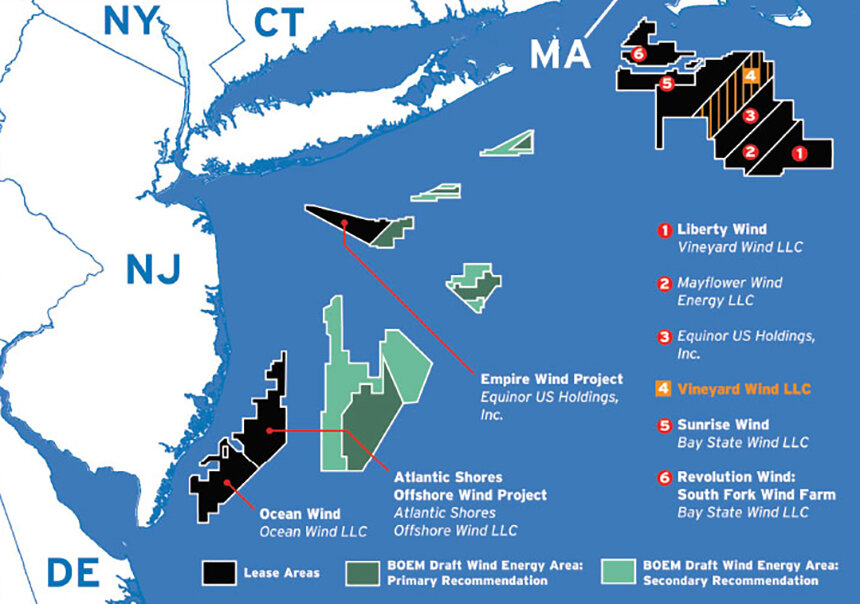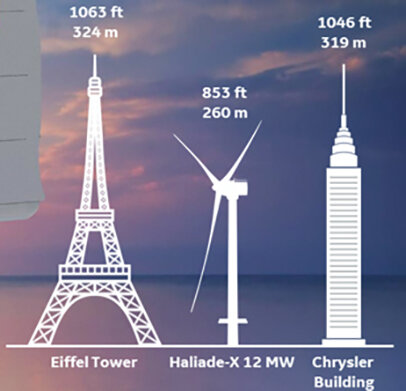By
TIM FAULKNER/ecoRI News staff

Six gigawatts of offshore wind energy have been proposed for the East Coast. (Engineering News-Record)
The forthcoming report from the federal Bureau of Ocean Energy Management (BOEM) on the cumulative environmental impacts of the Vineyard Wind project will determine the future of offshore wind development.
BOEM’s
decision isn’t just the remaining hurdle for the 800-megawatt
project, but also the gateway for 6 gigawatts of offshore wind
facilities planned between the Gulf of Maine and Virginia.
Another 19 gigawatts of Rhode Island offshore wind-energy goals are expected to bring about more projects and tens of billions of dollars in local manufacturing and port development.
Another 19 gigawatts of Rhode Island offshore wind-energy goals are expected to bring about more projects and tens of billions of dollars in local manufacturing and port development.
Some
wind-energy advocates have criticized BOEM’s 11th-hour call for the
supplemental analysis as politically motivated and excessive.
Safe
boat navigation and loss of fishing grounds are the main concerns among
commercial fishermen, who have been the most vocal opponents of the 84-turbine
Vineyard Wind project and other planned wind facilities off the coast of
southern New England.
Last
month, state Sen. Susan Sosnowski, D-New Shoreham, gave assurances that the
Coast Guard will not be deterred from conducting search and rescue efforts
around offshore wind facilities, as some fishermen have feared.
“The
Coast Guard’s response will be a great relief to Rhode Island’s commercial
fishermen,” Sosnowski is quoted in a recent story in The Independent. “We
have many concerns regarding navigational safety near wind farms, and that was
the biggest.”
The anticipated release of the BOEM report coincides with President Trump’s efforts to weaken environmental impact reviews for all energy proposals, including wind, coal, and natural gas.
National Environmental Policy Act (NEPA) reviews have slowed pipeline projects such as Keystone XL and, as of last summer, Vineyard Wind. Both industries praised the move to loosen environmental rules.
Environmentalists, meanwhile, fear that the removal of terms such as “cumulative,” "direct," and "indirect" from NEPA’s directives will nullify future federal efforts to address the climate crisis.
Once
the expanded environmental impact statement is released, BOEM will offer a
comment period and hold public hearings
Stephens
leaves Vineyard Wind
Barrington native and Providence resident Erich Stephens resigned at the end of
2019 from Vineyard Wind, a company he helped found in 2009 and is now co-owned
by Avangrid and Copenhagen Infrastructure Partners. The original wind company
was called Offshore MW. Prior to Vineyard Wind, Stephens was head of
development for Bluewater Wind, one of the first U.S. offshore wind
companies.
Stephens
has considerable roots in Rhode Island. He attended Barrington High School and
received his undergraduate degree from Brown University. He was founder and
executive director of People’s Power & Light, now called the Green Energy
Consumers Alliance.
He was also a founding partner of Solar Wrights, a residential solar company that was based in Barrington and moved to Bristol. The company was later acquired by Alteris Renewables. Stephens also worked for two of Rhode Island’s first oyster farms.
He was also a founding partner of Solar Wrights, a residential solar company that was based in Barrington and moved to Bristol. The company was later acquired by Alteris Renewables. Stephens also worked for two of Rhode Island’s first oyster farms.
More
megawatts
New York plans to add 1,000 megawatts of offshore wind power to the 1,700 megawatts it awarded last summer to offshore wind projects that will deliver electricity to Long Island and New York City.
New York plans to add 1,000 megawatts of offshore wind power to the 1,700 megawatts it awarded last summer to offshore wind projects that will deliver electricity to Long Island and New York City.
The
state also announced it’s taking bids for $200 million in port development
projects that will support the offshore wind industry.
The
recent notifications are part of the state’s Green New Deal, which
aims for 9 gigawatts of offshore wind by 2035 and 20 large solar arrays,
battery-storage facilities, and onshore wind turbines in upstate New York. The
state aims for 100 percent renewable energy by 2040.
The
latest offshore wind projects consist of the 880-megawatt Sunrise
Wind facility, developed by Ørsted and Eversource Energy, to power
Manhattan. Long Island will receive up to 816 megawatts from the Empire Wind facility, developed by Equinor
of Norway.
Pricing
for the projects hasn’t been made public.
Offshore
leader
 Based in Denmark, Ørsted is the early leader in the size and
number of U.S. offshore wind projects. Ørsted was awarded the 400-megawatt Revolution Wind project for Rhode Island.
Based in Denmark, Ørsted is the early leader in the size and
number of U.S. offshore wind projects. Ørsted was awarded the 400-megawatt Revolution Wind project for Rhode Island.
It’s also developing the 1,100-megawatt Ocean Wind facility in New Jersey, a demonstrations project in Virginia, and projects in Connecticut, Delaware, Massachusetts, and Maryland. The company acquired Providence-based Deepwater Wind in 2018 for $510 million.
 Based in Denmark, Ørsted is the early leader in the size and
number of U.S. offshore wind projects. Ørsted was awarded the 400-megawatt Revolution Wind project for Rhode Island.
Based in Denmark, Ørsted is the early leader in the size and
number of U.S. offshore wind projects. Ørsted was awarded the 400-megawatt Revolution Wind project for Rhode Island. It’s also developing the 1,100-megawatt Ocean Wind facility in New Jersey, a demonstrations project in Virginia, and projects in Connecticut, Delaware, Massachusetts, and Maryland. The company acquired Providence-based Deepwater Wind in 2018 for $510 million.
Ocean
Wind, New Jersey’s first offshore wind project, and the 120-megawatt
Skipjack Wind Farm off Maryland will use General
Electric’s huge 12-megawatt Haliade-X turbines.
The 853-foot-high turbines are the tallest in production and have twice the capacity of the 6-megawatt GE turbines now spinning off Block Island, which are 600 feet tall.
The 853-foot-high turbines are the tallest in production and have twice the capacity of the 6-megawatt GE turbines now spinning off Block Island, which are 600 feet tall.